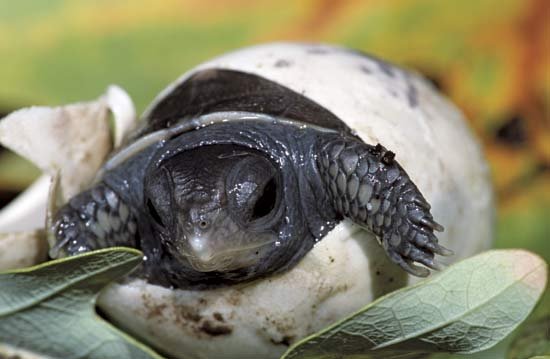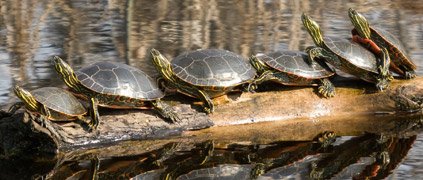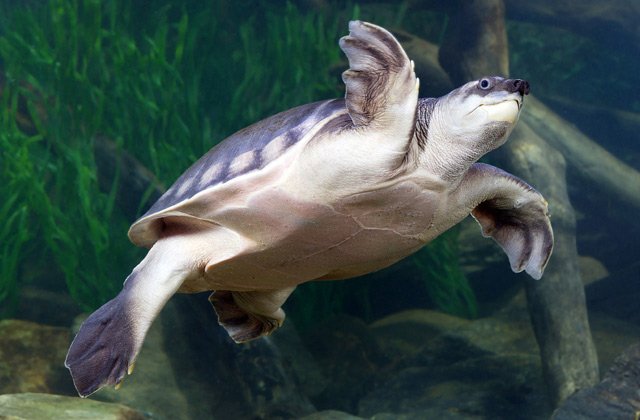Many turtle species around the world are listed as threatened or endangered, both as a result of natural and man-made causes. The primary reason for their decline is due to their long life histories; because turtles can live for so many years, some well over 100, many species take decades to reach reproductive maturity. Turtles face a huge number of threats, so when they reproduce they lay a massive quantity of eggs and play the probability game: if you lay enough eggs, chances are at least a few will survive to adulthood. A huge percentage of hatchling turtles are killed by natural and man-made threats long before they can ever reach sexual maturity (think of the sea turtle hatchlings trying to outrun predators to the ocean). In some box turtle species, only about 1 in every 100 hatchlings will survive to reproduce; in marine turtles, that number is closer to 1 in 1,000.

There are many conservation practices in effect to assist turtles, but the most widespread and well known is the "head start program". While most people may know of the program in regards to sea turtles, the head start initiatives are actually used for a variety of different turtle species around the world. The idea is simple; young hatchlings (and sometimes even eggs depending on the species' protective status) are collected and taken in to be cared for by humans for a brief time. During this period, the hatchlings can grow larger and stronger (hopefully outgrowing a few of their natural predators) and their shells become more rigid (turtle shells are quite soft for some time after hatching). The turtles are then released after about a month or so, with a critical head start that will increase their chances of survival. The programs have already shown remarkable success among many species, including marine turtles, however a new discovery may impact the conservation efforts of some freshwater species.

In general, turtles are not incredibly social animals. They may appear to live in large groups, however they are less of a unit and more of a collection of individuals making use of local resources and occupying the same general area. They don't really like or dislike one another, they just kind of coexist. Even when they rest against each other while sunning on a log, they are usually just competing for the warmest spot rather than engaging in any social behavior.

Until 2014, most scientists did not believe freshwater turtles had any sort of complex social interactions or postnatal parental care. The Wildlife Conservation Society has now revealed that at least two species, the pig-nosed turtle (also called the Fly River turtle) of Australia, New Guinea, and Indonesia, and the giant South American river turtle in Brazil, do exhibit some measure of vocalization among individuals. While studying pig-nosed turtles, the researchers recorded 182 simple calls made by seven turtles in the wild and in a breeding facility; the turtles communicated with one another while feeding, basking and nesting (source).

This discovery has several implications when it comes to the conservation of the Vulnerable-listed species. If the turtles rely on sounds for social cues, they may face environmental stresses from sources that weren't previously taken into consideration when planning for their protection.
"Understanding how turtles communicate is important to help to protect them. Noise pollution produced by ships, boats, jet skis, and other motorized watercraft may affect the reception of sound by turtles and potentially interfere with their communication." - Camila Ferrara, lead author of the study, WCS Source
However, the biggest problem is that the current conservation strategies are likely negatively affecting the success of the turtles. The head start programs, which generally isolate hatchlings (to prevent spread of disease/parasites and reduce stress from overcrowding), may be negatively impacting the critical social interactions among females and hatchlings. WCS managers now immediately release the pig-nosed turtles after hatching, rather than holding them for a month, so that the young turtles can properly develop their social behaviors and interactions.

Social animals need to have the opportunity to interact with one another if they are to thrive; it is crucial to their psychological health. Humans, for instance, are incredibly social animals; if you were to isolate a baby (pretending for a moment it was self-sustaining) and have it grow up separated from other human beings, imagine the sociopathic behavior we could expect that individual to exhibit as a result of not engaging in critical social interactions. Sure, they would probably survive, but definitely not with an optimal mental state (yes, I know that is a drastic oversimplification of the sociology/psychology, but it's just to make a point). Movies have even demonstrated this to a degree; in 2015's Jurassic World, Christ Pratt's character explains that the Indominus Rex suffers as a result of the lack of socialization with other animals, as compared to his velociraptors which have grown together and engage in their natural social behaviors.

The big difference being that when turtles aren't exposed to socialization, they don't go on a murderous rampage.
Studies such as this are critical to the conservation of endangered species. All species on Earth have their unique lifestyles and characteristics which can drastically affect how they respond to conservation strategies. What works for one species could be incredibly detrimental to another. Thanks to the researchers at WCS, turtle conservation managers can make sure their animals grow up with the necessary social structures they require, better enabling the species to rebound.
Article Link: https://www.sciencedaily.com/

Interesting reading. I always wondered whether turtles truly were more social than other species. Keeping a couple of herps myself it has always been hammered in from day one "keep them alone, they are antisocial and stress each other out even when they don't fight", but turtles always seemed exempt from that.
It's not surprising that the noise vibration affects them so badly, there is currently a huge debate about the effect of underwater sonar and military testing. Mostly on whales and dolphins but it's likely to affect everything. Especially that even species that cannot hear may still be affected by the vibration of the sound itself.
I enjoyed reading about freshwater turtles as well, all the conservation stuff you usually hear about is sea turtles. Thank you for sharing, I love reptiles and I really hope this information helps us protect them.
Downvoting a post can decrease pending rewards and make it less visible. Common reasons:
Submit
awesome
Downvoting a post can decrease pending rewards and make it less visible. Common reasons:
Submit
Hope the turtle does not go the way of the Dinosaurs. But it doesn't look good for some turtle species.
Downvoting a post can decrease pending rewards and make it less visible. Common reasons:
Submit
nice article! still so much to learn about the environment and the other creatures we share it with. since i was young i've always found turtles fascinating and if i could have a pond there'd be turtles in it ;)
Downvoting a post can decrease pending rewards and make it less visible. Common reasons:
Submit
Excellent post, thanks for sharing.
Downvoting a post can decrease pending rewards and make it less visible. Common reasons:
Submit
Hi! Very nice pictures you are a great photographer! I didn't know any of that information you put and I love turtles so I sure it I love you learn new things , happy day to you🕊🕊
Downvoting a post can decrease pending rewards and make it less visible. Common reasons:
Submit
Actually, these aren't my photos, these are from other great photographers around the web! There are links to the original sources at the bottom of the page. I post a few of my own photos now and then, but unfortunately I don't have photos of a lot of the animals I write about.
Downvoting a post can decrease pending rewards and make it less visible. Common reasons:
Submit
But you put great information and for that I an grateful🌻
Downvoting a post can decrease pending rewards and make it less visible. Common reasons:
Submit
Thank you!
Downvoting a post can decrease pending rewards and make it less visible. Common reasons:
Submit
Great info. Delaying the release of young turtles is a very simple solution, I hope the researchers are right and this will greatly increase turtle survival.
Noise pollution effects in human have been highly underestimated for decades, I won´t be surprised if the effects for animals are bigger than expected too.
I did not know that Chris Pratt stared at Jurassic World, another reason for watching the film.
Downvoting a post can decrease pending rewards and make it less visible. Common reasons:
Submit
This post received a 3.6% upvote from @randowhale thanks to @herpetologyguy! For more information, click here!
Downvoting a post can decrease pending rewards and make it less visible. Common reasons:
Submit
I am so happy to have come across your posts. I love nature and am so happy that there are wonderful organizations doing so much now to aid these precious creatures to survive. following and resteeming your awesome post. Thank you.
Downvoting a post can decrease pending rewards and make it less visible. Common reasons:
Submit
Very interesting article. I actually run a sea turtle head-starting program, and we don't isolate them, but instead keep them in artificial ponds together. The number of turtles in each pond depends on their size, we try to make sure they always have plenty of room to be alone if they want to be, and give them places to hide (old clam shells, coconut branches, etc) you can see one of our juvenile turtles here:

Downvoting a post can decrease pending rewards and make it less visible. Common reasons:
Submit
Downvoting a post can decrease pending rewards and make it less visible. Common reasons:
Submit